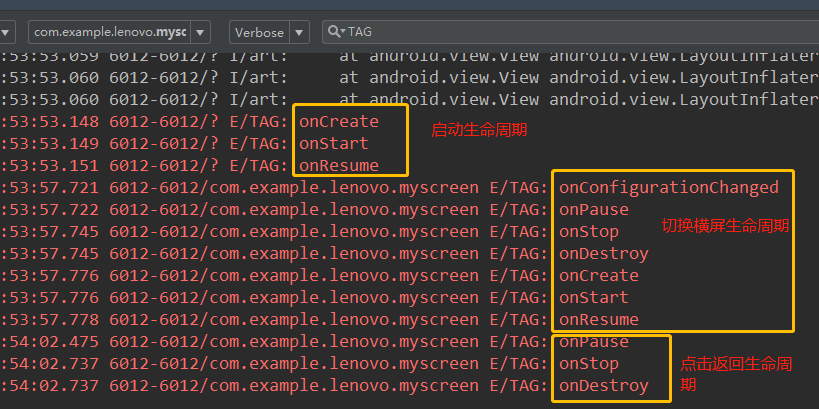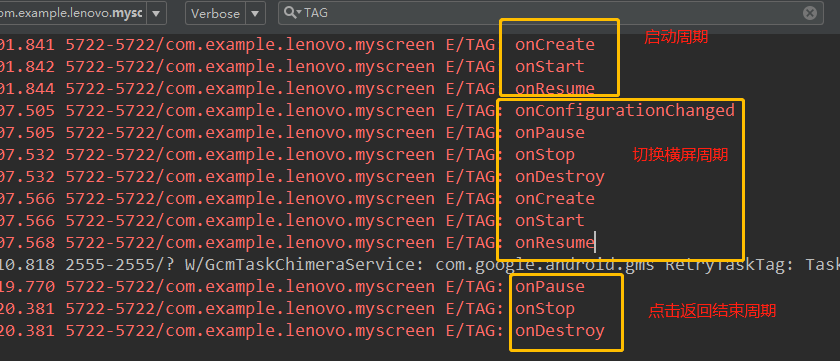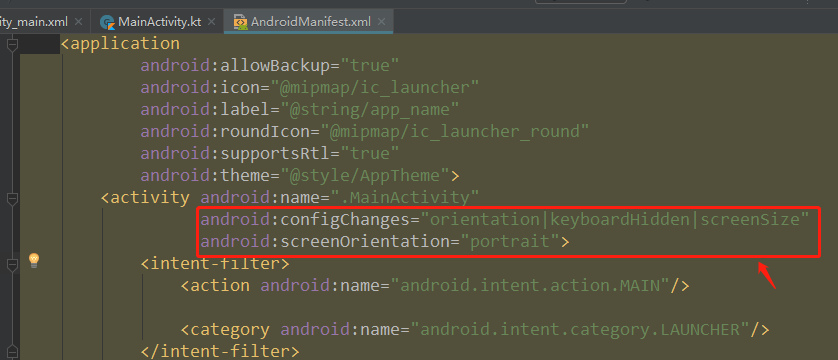安卓屏幕横竖屏切换以及生命周期演示
关于安卓屏幕横竖屏切换及其生命周期的演示:
(1)什么都不设置的一个生命周期:(生命周期会回调,走两次)
启动---> 切换横屏---> 点击返回结束

(2)只设置了如下方法:(生命周期也会回调走两次)

启动---> 切换横屏---> 点击返回结束

(3)在AndroidMainfest.xml里设置如下两个方法的一个生命周期(这个时候切换的时候会走onconfigChange()方法,不回调了,只走一次完整生命周期)


启动---> 切换横屏---> 点击返回结束

(4)相关代码:
布局xml代码:
<?xml version="1.0" encoding="utf-8"?> <android.support.constraint.ConstraintLayout xmlns:android="http://schemas.android.com/apk/res/android" xmlns:tools="http://schemas.android.com/tools" xmlns:app="http://schemas.android.com/apk/res-auto" android:layout_width="match_parent" android:layout_height="match_parent" tools:context=".MainActivity"> <Button android:layout_width="wrap_content" android:layout_height="wrap_content" android:text="切换横竖屏" android:onClick="changeScreen"/> <TextView android:id="@+id/text_screen" android:layout_width="match_parent" android:layout_height="wrap_content" android:text="Hello World!" app:layout_constraintBottom_toBottomOf="parent" app:layout_constraintLeft_toLeftOf="parent" app:layout_constraintRight_toRightOf="parent" app:layout_constraintTop_toTopOf="parent"/> </android.support.constraint.ConstraintLayout>
Activity代码:(此处用koltin代码实现)
class MainActivity : AppCompatActivity() { /** * 屏幕横竖屏切换,和生命周期管理 */ override fun onCreate(savedInstanceState: Bundle?) { super.onCreate(savedInstanceState) setContentView(R.layout.activity_main) //获取当前的时间 val format = SimpleDateFormat("yyyy-MM-dd HH:mm:ss") val time = format.format(Date()) text_screen.text="onCreate"+time //给TextView设置点击事件清除文字 text_screen.setOnClickListener(object : View.OnClickListener { override fun onClick(v: View) { text_screen.text = "重新来!" } }) Log.e("TAG", "onCreate") } //改变横竖屏切换的方法 fun changeScreen(view: View) { /** * int ORIENTATION_PORTRAIT = 1; 竖屏 * int ORIENTATION_LANDSCAPE = 2; 横屏 */ //获取屏幕的方向 ,数值1表示竖屏,数值2表示横屏 val screenNum = resources.configuration.orientation //(如果竖屏)设置屏幕为横屏 if (screenNum == 1) { requestedOrientation = ActivityInfo.SCREEN_ORIENTATION_LANDSCAPE //设置为置屏幕为竖屏 } else { requestedOrientation = ActivityInfo.SCREEN_ORIENTATION_PORTRAIT } } //屏幕方向发生改变的回调方法 override fun onConfigurationChanged(newConfig: Configuration) { if (newConfig.orientation === Configuration.ORIENTATION_LANDSCAPE) { text_screen.append("\n 当前屏幕为横屏") } else { text_screen.append("\n 当前屏幕为竖屏") } super.onConfigurationChanged(newConfig) Log.e("TAG", "onConfigurationChanged") // setRequestedOrientation(ActivityInfo.SCREEN_ORIENTATION_LANDSCAPE); //设置横屏 } override fun onStart() { super.onStart() text_screen.append("\n onStart") Log.e("TAG", "onStart") } override fun onRestart() { super.onRestart() text_screen.append("\n onRestart") Log.e("TAG", "onRestart") } override fun onResume() { super.onResume() text_screen.append("\n onResume") Log.e("TAG", "onResume") } override fun onPause() { super.onPause() text_screen.append("\n onPause") Log.e("TAG", "onPause") } override fun onStop() { super.onStop() text_screen.append("\n onStop") Log.e("TAG", "onStop") } override fun onDestroy() { super.onDestroy() text_screen.append("\n onDestroy") Log.e("TAG", "onDestroy") } //AdMainfest.xml里加这个两个和不加的区别: //android:configChanges="orientation|keyboardHidden|screenSize" //android:screenOrientation="portrait" //或者只设置: //android:configChanges="orientation" }
AndroidMainfest.xml代码:
<?xml version="1.0" encoding="utf-8"?> <manifest xmlns:android="http://schemas.android.com/apk/res/android" package="com.example.lenovo.myscreen"> <application android:allowBackup="true" android:icon="@mipmap/ic_launcher" android:label="@string/app_name" android:roundIcon="@mipmap/ic_launcher_round" android:supportsRtl="true" android:theme="@style/AppTheme"> <activity android:name=".MainActivity" android:configChanges="orientation|keyboardHidden|screenSize" android:screenOrientation="portrait"> <intent-filter> <action android:name="android.intent.action.MAIN"/> <category android:name="android.intent.category.LAUNCHER"/> </intent-filter> </activity> </application> </manifest>
(5)注意:
A:configChanges属性
configChanges属性可以设置多个值,中间使用竖线分割;
1. orientation 屏幕在纵向和横向间旋转
2.keyboardHidden 键盘显示或隐藏
3.screenSize 屏幕大小改变了
4.fontScale 用户变更了首选的字体大小
5.locale 用户选择了不同的语言设定
6.keyboard 键盘类型变更,例如手机从12键盘切换到全键盘
7.touchscreen或navigation 键盘或导航方式变化,一般不会发生这样的事件
其中前面三个是常用的,后面的属性很少用!
如果要Activity中的生命周期不回调,就要设置:android:configChanges="orientation|keyboardHidden|screenSize"
注意一定要设置这三个值,否是生命周期会被回掉
B:screenOrientation属性
screenOrientation有如下选项:
1.unspecified 默认值,由系统判断状态自动切换
2.landscape 横屏
3. portrait 竖屏
4.user 用户当前设置的orientation值
5. behind 下一个要显示的Activity的orientation值
6. sensor 使用传感器 传感器的方向
7. nosensor 不使用传感器 基本等同于unspecified
screenOrientation只能选一个值!一般设置都是横屏或竖屏,其他也很少用
C:onConfigurationChanged方法
//屏幕方向发生改变的回调方法 @Override public void onConfigurationChanged(Configuration newConfig) { if (newConfig.orientation == Configuration.ORIENTATION_LANDSCAPE) { text_screen.append("\n 当前屏幕为横屏"); } else { text_screen.append("\n 当前屏幕为竖屏"); } super.onConfigurationChanged(newConfig); Log.e("TAG", "onConfigurationChanged"); // setRequestedOrientation(ActivityInfo.SCREEN_ORIENTATION_LANDSCAPE); //设置横屏 }
前提是AndroidMainfest.xml中已经定义了:android:configChanges="orientation"



